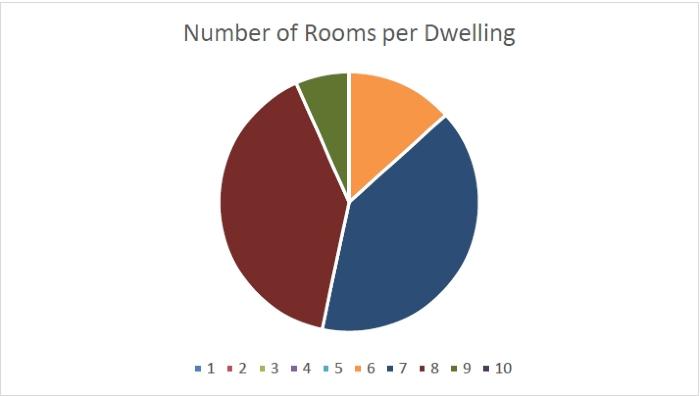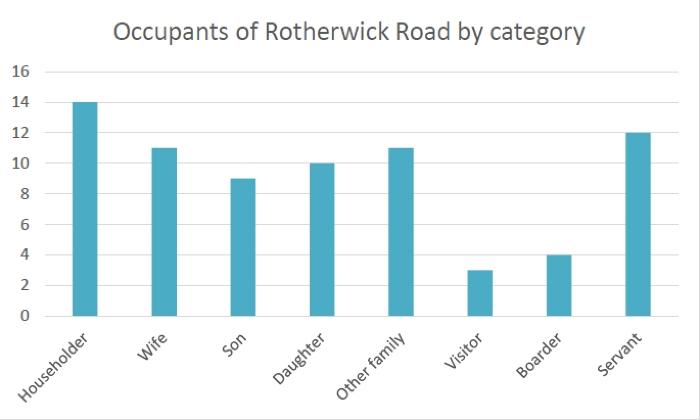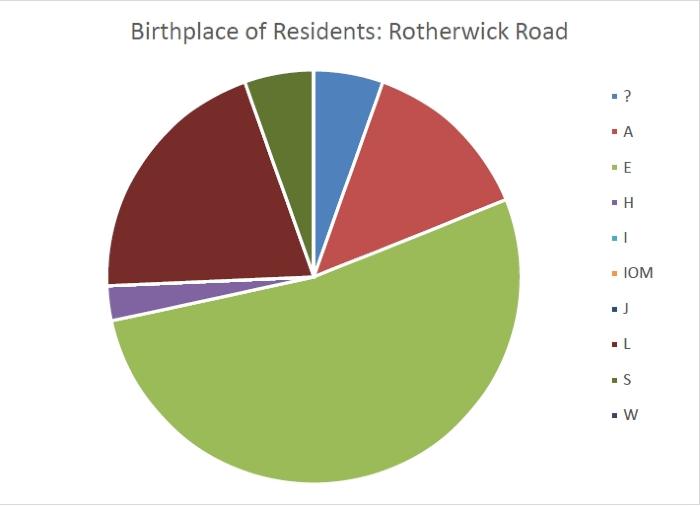Census 1911 Rotherwick Road description
Type of homes
Rotherwick Road was only partially built. 18 houses were completed, of which 3 were unoccupied on Census night. 27 properties were under construction (on the uneven side of the road).
All were relatively large, averaging 7.4 rooms. They were quite high-status homes due to proximity to Golders Green station and the Heath Extension. 40% of the houses had 7 rooms, 40% had 8 rooms (see pie chart).

Who lived here?
Of the 15 occupied houses, there are Census returns for 14. The Drysdale family, who were prominent pro-Suffrage campaigners were Census refusers (see under Personalities later).
74 persons were living in the 15 occupied homes, at an average of 4.9 persons per house. Most had a male head of household, with only two (13%) having a female head. Most householders were married (80%). Two of the male heads of house were single men. The average length of marriage was 12.3 years. This was longer than some other Suburb roads, although similar to those with larger houses where an established career would have been needed to afford the rent and other outgoings. Similarly, the average age of the householders was 42 years and their wives was 41.5 years. Only one person in the road was over 65 years. This would have been due to a range of factors, particularly lower life expectations at the time.
There was a marked imbalance of females to males with a ratio of about 2:1. This was a feature throughout the Suburb, partly due to the tendency for unmarried women to remain in the family home, but here also the result of household employing ‘live-in’ servants. Two thirds of the homes had a servant (one had two). (Much higher level than most roads in the Suburb at this time, but it is similar to nearby high status roads e.g. Heath Close and Reynolds Close.
In terms of the make-up of the household members, servant was actually the largest category (slightly ahead of wives). See table below:

Almost half of the households included children under 16. Usually there were one or two children per family, but the averages are distorted by two families with 5 children each.

There was some evidence of extended families in this road. Joel Ledsham at 45 was single, but his household included his mother and two unmarried sisters. One household consisted of two young married couples who were related. Unusually, both women were working (one as a vocalist and the other as a clerk) and presumably this arrangement allowed them to afford better living arrangements than might have been possible as individual couples. The Bedells household had 3 female boarders; all of whom worked in the theatre, whilst the daughter of the house was a talented ballet dancer (see under personalities). The family probably moved from Bristol to London to support their daughter as there was little suitable housing for young women in London (see also Waterlow Court)
Origin of residents
The road has the lowest percentage of residents born in London at 20.3%. Only two of the 14 heads of household were London born. More than 50% were born elsewhere in England, showing the pull of London as a source of employment, especially for those in the professionals.
There was also a relatively high proportion of residents born outside the British Isles (13.5%). These are largely in two families. The Hart family from New Zealand, consisted of Arthur (the head of household) a single man of private means, together with his sister-in-law and two nieces. The Otis family was from the USA and Mr Otis was a Hide Sales Manager. In many other Suburb roads the children had often been were recent movers to London, rather than movers with London.
Graph showing origins of the residents is below:
Key to birthplace groupings:
? - Unknown
A - Abroad
E - England (other than London & Home Counties)
H – Home Counties
I – Ireland
IOM- Isle of Man
J – Jersey
L – London
S – Scotland
W - Wales

The occupations of the heads of household are quite varied, although predominantly professional and self-employed. Examples included a senior Civil Servant, a Consulting Engineer, and a skirt manufacturer. There are two households where the head of household is directly related to the development of Hampstead Garden Suburb. Albert Chapelow at 1 Rotherwick Road was the Landscape Gardener for the Hampstead Garden Suburb Development Company, whilst Reuben Davis was Builder’s Manager for the company building houses in HGS.
Residents of interest
1 Rotherwick Road - Albert Chapelow:
Landscape Gardener, employed by the Hampstead Garden Suburb Development company.
9 Rotherwick Road – Alfred Seabold Ackermann
Self-employed Consultant Engineer. Secretary of the Society of Engineers for many years. Was interested in fuel economy and wrote on use of machinery in mining. Also interested in use of solar energy. Remained here until he died in 1951.
10 Rotherwick Road - Reuben Davis
Was from Loughborough and a Builder’s Manager for the firm William Moss and Sons of Loughborough who built much of the pre–WW1 Suburb.
11 Rotherwick Road – The Bedells family and boarders
Albert was Secretary to the Bristol Gas Company, but his daughter (Ethel) Phyllis Bedells was of greater interest. She was to be key in the development of Royal Academy of Dance; was a founding member and helped to develop its curriculum. Pictures in NPG collection Trained in the French, Italian, Danish and Russian schools of ballet, including being taught by Anna Pavlova. She went on to develop her own versatile British style. Engaged at London’s Empire Theatre, she became the first British ‘prima ballerina’ in 1913. 1916 onwards danced in West End and at Covent Garden. She was also a guest artist with the Vic-Wells ballet, a predecessor of the Royal Ballet and had a successful dance partnership with Anton Dolin in the late 1920s.
Also boarding at the house were Helen Vera Carter aka Nell Carter – a well-known actresses and Adrienne Andean who was a singer with the D’Oyly Carte Opera Company
49 Rotherwick Road – The Drysdale family
Family was prominent in campaign for women’s suffrage. Census form returned blank by wife (Bessie):
As the Government refuses me a vote, and as I am not recognized as a citizen, I refuse to perform the duties of one, in giving the information required by the Government”.
She signed herself as a member of the Women’s Freedom League. A reduced return was completed by the enumerator.
Bessie Drysdale
A founder member of the Women’s Freedom League (WFL) (with Edith How Martyn – see Hogarth Hill) on its first National Executive Committee. The WFL was a non-violent suffragette movement which separated from Emmeline Pankhurst’s Women’s Social and Political Union (WSPU). Originally trained as a teacher. Was also arrested, appearing at Westminster Magistrates Court on 14/2/1907. Frequent speaker for the Women’s Freedom League, especially on topics such as women’s health and contraception. Joint Secretary of WFL branch in HGS.
After WW1, undertook considerable campaigning and educational work across the country on contraception and women’s health. Secretary of Malthusian Society and assisted her husband, Charles in establishing the Walworth Women’s Welfare Centre.
Charles Vickery Drysdale FRSE CB OBE (1874–1961)
Son of Drs Charles Drysdale and Alice Vickery (see below)
Was an electrical engineer by training. During WW1 was involved in experimental work for the Admiralty. Continued after the war eventually Director of Scientific Research at The Admiralty from 1929-34. He was co-founder of the Institute of Physics and served as its Vice-President 1932–1936.
Pro-women’s suffrage and a social reformer. Founded the Men’s League for Women’s Suffrage. He also sat on the Men’s Committee for Justice for Women.
He was also Secretary of the Malthusian League (the first British organisation campaigning for birth control. He opened the first birth control clinic in Britain in 1921(marked by a blue plaque in Walworth) assisted by Bessie (though she is not mentioned on the plaque). Co-founder the Family Planning Association in 1930.
Both wrote for the ‘The Freewoman’ publication (as did Rebecca West of 5 Chatham Close)
Alice Vickery Drysdale.
Was the mother of Charles Vickery Drysdale. Was probably living here in 1911, but completely evaded the Census.
Was England’s first qualified female pharmacist and druggist in 1873. Also achieved a degree in midwifery in 1873.
Went to medical school in Paris, (women couldn’t qualify in England), returning to England as soon as women were able to register as doctors. Was one of the first five women registered in 1880.
Long term campaigner for a range of social issues, especially birth control and women’s suffrage. Initially a member of NUWSS, then WPSU before moving to the WFL. Was also a member of the Women’s Anti-Taxation League and had goods confiscated for withholding property taxes for this address.
55 Rotherwick Road - David Shackleton
Listed as ‘Senior Civil Servant’ on his census form but had a fascinating back-story. Subject of a book entitled: “The Lancashire Giant”. Born into poverty near Rawtenstall in Lancashire in 1863. Became a cotton worker at the age of 9. Was an active trade unionist, rising through the cotton weavers’ unions to become General Secretary of the Textile Factory Workers Association. In 1902, elected unopposed as only the 3rd ever Labour MP for Clitheroe. Played a critical role in the infancy of the Labour Party and was especially active on trade union matters; instrumental in the passing of the 1906 Trades Disputes Act and became President of the Trade Unions Congress in 1908.
In 1910, Winston Churchill invited Shackleton to join the civil service as senior labour adviser at the Home Office so he left Parliament. Rose to become Permanent Secretary in the Ministry of Labour During the First World War, he contributed to Lloyd George’s War Cabinet and was knighted in 1917. Retired 1925.